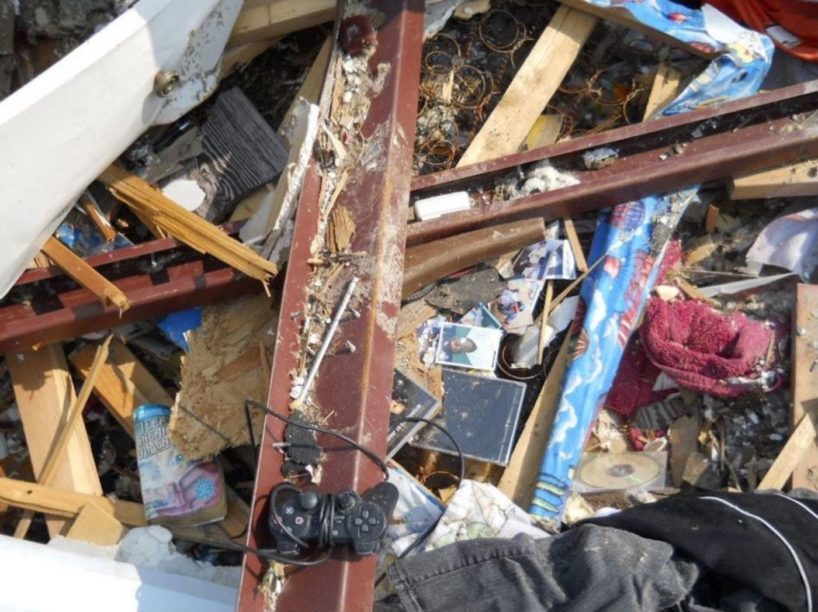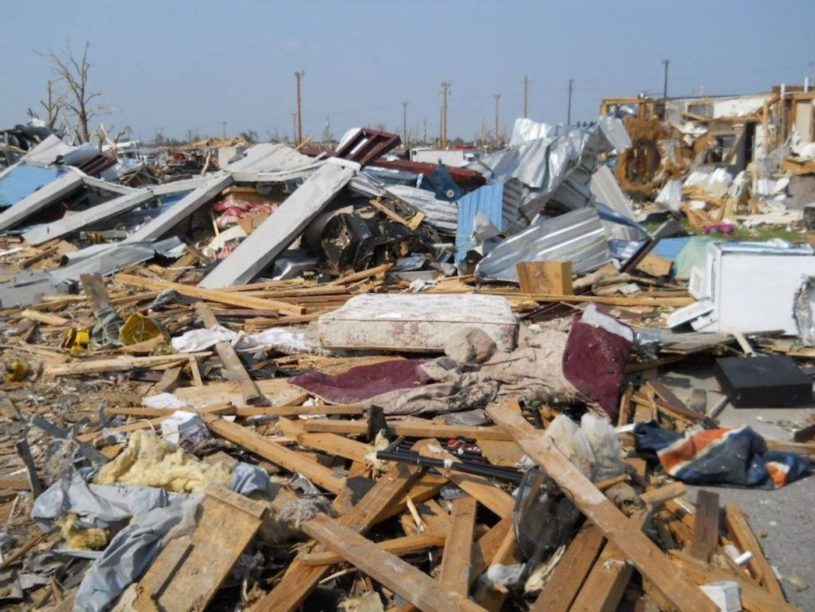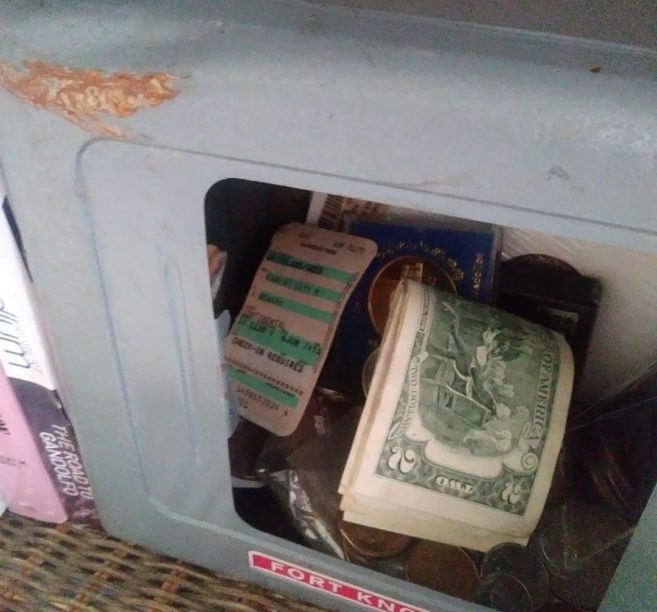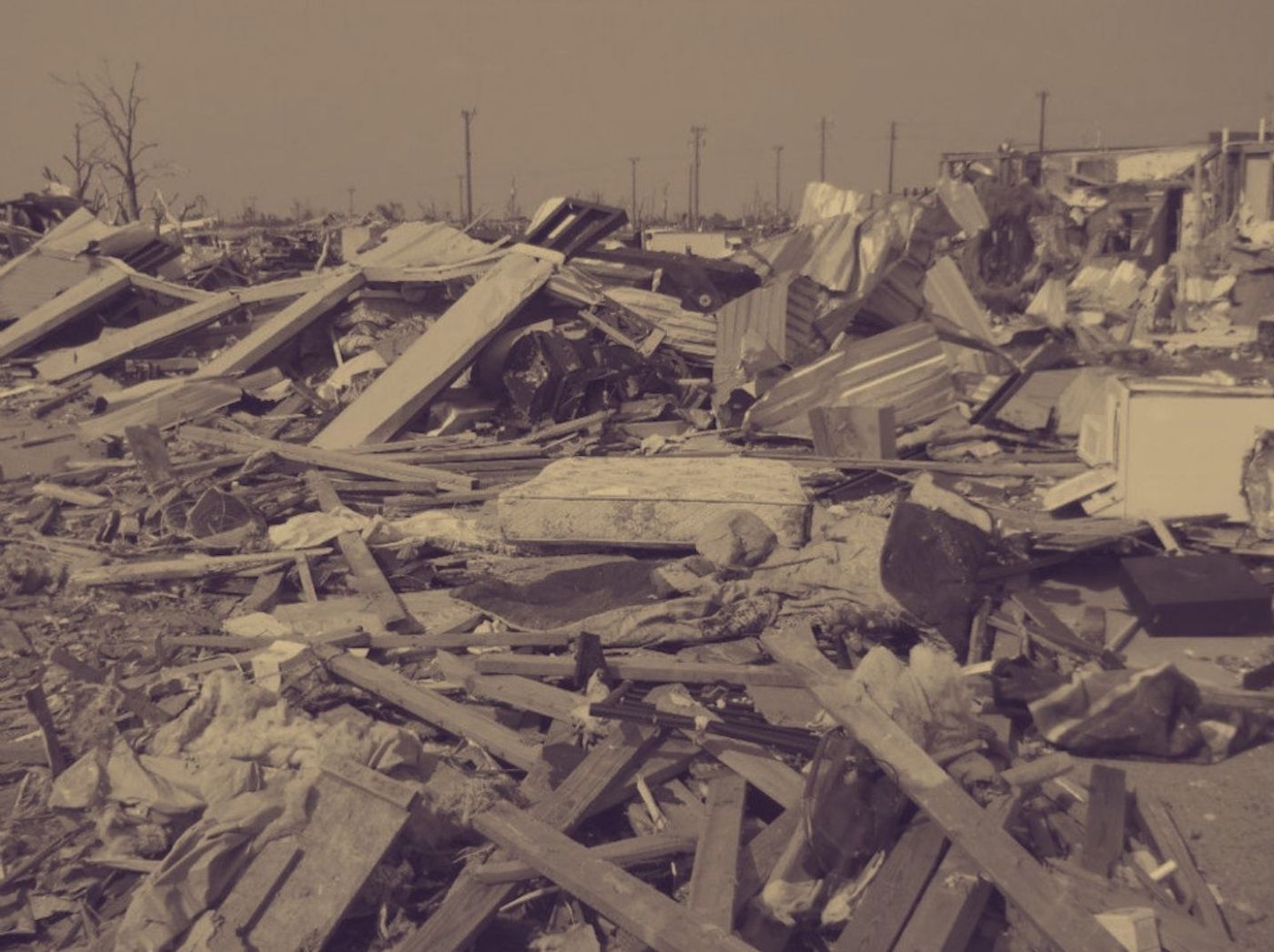My concern is, if I begin with the dildos, it’s gonna ruin the rest of it. So at the risk of being accused of burying the lede, I’m not going to start off with how the Joplin Tornado made it rain dildos on Duquesne, Missouri.
I’ll start with a memorial.
Will Norton was probably one of the first casualties of the deadly EF5 tornado that struck Joplin on May 22, 2011. He was in a car with his father on the southwest side of town, near where the funnel must’ve dropped. He’d just received his high school diploma, and he was a “YouTuber” in the days when that was still a fun and innocent thing for teens to do. His body was sucked out of the sunroof of an SUV. They found him three days later in a pond not far from 26th and Schifferdecker Road. My wife’s dad went to high school with Will’s dad. My wife grew up playing at the Norton house.
Will was likely one of the first victims, and the first that we knew personally. He wouldn’t be the last.
The next one would be Dorothy Bell, an elderly woman who lived with her son, my friend David, at 27th and Jackson Avenue. Their home is four blocks due west of St. John’s Hospital. The same hospital that the Weather Channel’s Mike Bettes would break down and cry in front of on live TV later. The same hospital where my wife’s mother, my mother, and my wife would all work, separately.
Dorothy and David were at home when the sirens went off. They didn’t have a basement, so they sought refuge in the interior hallway. The vortex completely flattened their house. Dorothy had a heart attack. It took David a while to dig himself out of the rubble and longer still to find his mother. By then it was too late. Fox News watchers might recall their names, because David ended up on Fox News, after Dorothy’s body went missing in one of the temporary morgues for a week. Maybe “went missing” isn’t the right word. They lost the body.
In mass casualty events refrigerated truck trailers – the ones that haul heads of lettuce, ice cream, packaged beef, and all the various perishables that line your grocery store shelves – are often commandeered to serve as temporary morgues for storing human remains. This happened after Hurricane Katrina, in Joplin, in New York during the initial wave of COVID-19. The federal government has put out instructions for how to clean and disinfect those trailers so they can go back to hauling foodstuffs.
They finally found Dorothy Bell’s body eight days later.
From west to east, Schifferdecker, Maiden Lane, Main Street, Connecticut Avenue and Range Line are the main north-south traffic arteries in Joplin. From south to north, the east-west routes are numbered: 32nd Street, 26th Street, 20th Street, 15th Street, and so on. The southern edge of the tornado is crossing Main Street at 26th. Over the course of 38 minutes, it will remain on the ground.
Four blocks up and two blocks to the west of Main, it’s throwing a tree through the roof of my coworker’s house. Fortunately, he’s in the Joplin Globe newspaper offices with me at 4th and Main Streets, 11 blocks north of any sign of what’s happening. Another colleague wasn’t as lucky.
Bruce Baillie had been a paginator at the Joplin Globe for years before I joined the staff as a cub reporter in July 2007. The only clear memory I have of him speaking during our four years working together is he once started shrieking at the commentators during the Preakness Stakes the year Big Brown failed in his Triple Crown bid. Bruce apparently had a thing for the ponies, or at least, had a thing for Big Brown. He lived in an apartment near the 2600 block of Connecticut Avenue. That’s roughly eight blocks east of Joplin High School. The “O” and the “P” remained on the school, and someone made a duct-tape “H” and a duct-tape “E” and stuck to it. Eventually blocks of carved wood and other totems would coalesce around the sign, while an impromptu community kitchen sprouted from the parking lot, started by a hunting guide from western Kansas and a gospel preacher from down in Georgia. Both had come to Joplin to help, and met as strangers in the “Hope High” parking lot. The high school took a direct hit and had to be completely rebuilt. So too, would Bruce’s apartment find itself on the receiving end of the full fury of the storm.
One-quarter of the Joplin Globe’s 117 employees would lose their homes. Bruce Baillie was the only one who also lost his life. I don’t know that I ever learned the specifics of how he died, just that he was home that night instead of at work. If he’d been at work with us, he would have survived.
It would be five full days before every person I knew who was missing was accounted for. I have friends who rode out the storm in their bathrooms, their basements, under stairwells, and in walk-in freezers. A young journalist I knew rode the whirlwind out in a walk-in cooler of a Conoco-Phillips gas station at 20th and Duquesne Road. You can listen to the harrowing audio (he’s the one chanting “We’re good! We’re good!”). There’s also video of the aftermath taken three days later. Another friend, her husband and children cowered in the bathtub at their house on 22nd and Alabama, listening to the funnel suck the bricks of their home off of the mortar with a “chuck-chucking” sound.
Later, when it was safe to return and survey the damage, she would carry away a brick from that house, as a talisman.
“Brick saved our lives,” she said.
****

For you coastal elites, a tornado is a narrow, violently rotating column of air that extends from a thunderstorm to the ground. Touching the ground is the key. Rotating clouds aren’t enough. A “condensation funnel” made up of water, dust and debris, will drop out of the sky and reach the earth, sucking up whatever’s in its path.
Like earthquakes, they have their own specialized metric – the Enhanced Fujita scale – for assessing their size and damage. An EF-0 would be a twister with sustained gusts of 65-85 miles per hour. An EF-5 would be one with winds up to 200 miles per hour.
The National Weather Service says approximately 1,200 of them hit the U.S. every year, most frequently between March and July. May is generally the most active month but it really depends on where you live.
While they have been observed in all 50 states, they are most prevalent in portions of the Southeast and Central Plains. Texas, Kansas, Oklahoma, Alabama, Missouri, South Dakota and most of the states in between. The 2011 tornado season was particularly intense, producing 1,691 tornados, including a deadly storm that devastated Tuscaloosa about a month before Joplin. The Joplin tornado is the costliest tornado in U.S. history to date, causing $2.8 billion in damages.
When it comes to tornado safety, you want to get as low to the ground as possible. And you want to shield your head and body from flying debris, so interior hallways, bathrooms with no windows, closets and the like are generally where you go to ride a tornado out if you don’t have a basement or a bonafide “storm cellar” to run to. Trying to outrun a twister while you’re in a vehicle is not advised. Experts say you’re actually safer if you abandon the vehicle and lie in a ditch by the road. But the concern there, in addition to the debris, is drowning in a flash flood in the ditch.
I was born, raised, and have lived most of my life in an area known as The Tri-State Mining District, which encompasses southeast Kansas, southwest Missouri, and northeast Oklahoma. It’s a place where tornadoes occur with some regularity. The vast majority of tornado warnings I’ve lived through have been extremely minor, in terms of both losses of life and loss of property. The EF5 tornado that hit Joplin was a completely different animal.
I have been in close proximity to two other deadly twisters. The first, an EF-4 that killed four people in the tiny hamlet of Franklin, Kansas, just north of my hometown of Pittsburg. That particular tornado passed about half a mile north of me as I was sitting in a parked Toyota RAV4, passing a bowl around with a coworker in his front yard in Mulberry, Kansas. We’d gone outside because the storm knocked out the power, ending our Madden game.
That same storm system would drop another EF-3 funnel that would damage my wife’s mother’s house, and a number of other buildings in downtown Carl Junction, Missouri, about 30 miles southeast of Franklin. Two more people died.
The second killer tornado happened on May 10, 2008. Like in 2003, this was a series of tornados that started in Picher, Oklahoma, killing six people and flattening the last 100 or so homes in an area. Homes that the residents were, despite being the heart of a massive Superfund site, fighting desperately to stay in rather than accept a government buyout and be relocated. They were given no choice but to move because federal and state aid dollars weren’t going to be used to rebuild in a town where the air, water, and earth are rife with lead mine tailings and the ground beneath your feet could split open at any moment and get sucked down into an abandoned mineshaft.
Fifteen more people were killed that same night on the Missouri side of the line in Newton and Barry counties. Prior to the Joplin tornado, this was the biggest national news story of my young journalism career. I was part of the press gaggle that followed then-Homeland Security Secretary Michael Chertoff on his tour of Picher.
I don’t recall anything particularly memorable or ominous on the morning of May 21, 2011 which would foreshadow what was to come. I’d spent the morning crappie fishing before showing up to the Globe headquarters for my last day of work. It was a lovely spring day. A number of area high schools were having graduations. The hope was that the rain and thunderstorms would hold off long enough to get the pomp and circumstance in.
It wasn’t until much later in the day, probably around 5 p.m., when the skies started looking like the color of doom. The first indication we got of how bad it could be was when the local NBC news broadcast we were watching went off the air. Their tower and studio are on the west edge of town, and they were among the first buildings to be damaged.
For starters, most tornadoes don’t stay on the ground for very long – less than 10 minutes typically. According to the National Weather Service’s Storm Event Database, the Joplin Tornado was on the ground for 38 minutes. In that time, it covered 22.1 miles and in some areas was a mile wide. One hundred and sixty-one people were killed. More than 1,150 were injured. It damaged 30 percent of the city, destroying or severely damaging 7,000 homes, 500 businesses, half of the school district, and the St. John’s Regional Medical Center hospital. Approximately 3 million cubic yards of residential debris was produced. The initial projected storm track was for it to stay on a sharp northeasterly route, heading for Missouri Southern State University. Our apartment was just west of campus
Usually when a tornado comes through, the path of destruction is more haphazard. It can sometimes look like the vortex drops down and picks up one house but leaves the neighbor’s untouched, or will tear a roof off here but not there. This wasn’t like that. Everything around as far as the eye could see to the east and to the west, was flattened. Flatter than hammered shit.
*****

There are other stories that will stay with me forever. The general track of the devastation was northeast. As the tornado approached Range Line Road, Joplin’s chief commercial thoroughfare, the cone of damage is radiating out from around 15th Street to the north, where the Walmart is, to 20th Street to the south, where the Home Depot is.
In between both big box stores is a Pizza Hut, where 15 patrons are eating their Sunday supper when the sirens go off. The manager, Christopher Lucas, ushers everyone, including his employees, into the walk-in freezer for their own safety. He loops a strap around the door handle and braces to hold it closed. The winds are too powerful though, and they suck the freezer door right off its hinges, and Lucas too, strapped to it as he is. Everyone else in the freezer survives. At home safe is Lucas’s girlfriend, who is pregnant with his third child.
Three Walmart employees across the street die when the store collapses. Their names and faces are memorialized on a mural at the front of the store when it reopens the following year, greeting every customer upon entry.
At the Home Depot, Army veteran Rusty Howard and his two children, Harli – age 5, and Hayze – age 19 months, have run inside to seek shelter. But when the winds carry away the roof, the four walls of the building collapse inward. Rescue workers will later find the Howard children in their father’s arms. The “tilt-up wall” construction method deployed by Home Depot and other big box stores will come under scrutiny from the Kansas City Star, for being particularly vulnerable to catastrophic failure in the event of a tornado.
Not all of the storm’s 161 victims died instantly. Some lingered on in hospitals for days after. But in my mind, the last official victim of the storm is Jeff Taylor, a police officer from Riverside, a small community in Kansas City’s northland, who answered Joplin’s call for aid. Taylor was struck by lightning while on disaster relief duty on Monday, May 23, 2011, as the last remnants of the storm front that generated the tornado were blowing through. The storm dumped around eight inches of rain on the town, which is part of the reason the property damage was so catastrophic. Many of the homes and businesses that remained standing had to be demolished anyway due to flood damage.
The thing about the devastation you see in pictures of the Joplin tornado is that none of them capture the scope. Everything was matchsticks. The storm crushed SUVs the way you’d crush a beer can in your fist. Parking lots with balls of metal in them. The Weather Channel’s Jim Cantore described steel beams “twisted like licorice.” Bits of fiberglass insulation were stuck to everything. The winds were so intense, they pulled the bark off of tree trunks. So that even the few mature trees that weren’t ripped out of the ground root and branch still died when their very skin was sucked off.
“It looks like God pushed a mile-wide lawnmower over the southern part of Joplin,” a local news talk radio broadcaster said as we tried to make sense of the carnage in the days after. Everything did have a chewed-up-and-spit-out quality to it. Some things, like medical records from St. John’s Hospital, were scattered to Ash Grove, almost 70 miles northeast. Bulkier items also ended up in strange and unexpected settings.
On Tuesday, May 24, another round of tornadic storms would threaten the community, still digging out from Sunday’s cataclysm. We made sure to take shelter in my older sister’s basement, on the north side of town. Everyone’s social media timelines had messages like “There are six of us sheltering in the basement at 307 S. Pearl Ave” so loved ones would know where to start digging if the worst was yet to come.
As is often the case in tornado warnings, while the conditions for a vortex to drop were favorable, nothing much happened. All sound, but none of the fury from two days previous. The only other significant thing to note was it would be 116 days before a drop of rain would fall on Joplin. (The next time it would rain would be on our wedding day.) We were in for the hottest, driest summer in living memory, and for the relief workers and responders in the disaster zone, where there was no power, no shelter and no shade, it was fixing to be a long, stifling summer.
Driving through the disaster zone at night was haunting. For months, there was no light of any kind at night. Not street lights, or porch lights, or neon “Open” signs. It was the kind of pitch-black that made you feel swallowed. From the right hill on the east side, you could look west and see nothing but desolation. And overlooking it all was the skeleton of St. John’s hospital. There used to be neighborhoods, parks, businesses. Lush green trees would’ve blocked your view. All of it was just gone.
****
Now, okay, might as well get to this part: In the parking lot in front of Home Depot is a shop called “Christie’s Toy Box.” It’s a sex toy shop. I’d never been in Christie’s, but the joke was that more than one Puritanical Assemblies of God-worshipping family had entered the business expecting to find kid’s toys.
The tornado obliterates Christie’s Toy Box and rains dildos and “other battery-operated items” on yards a couple of miles away in the hamlet of Duquesne.
That story got some mileage online, maybe you read about it.
*****
I would be remiss if I didn’t mention the many Joplin Globe staffers who dug out of their wrecked homes and came to work. There’s a wonderful documentary short called Deadline in Disaster about how my colleagues crawled out of the rubble of their shattered homes and made their way to the newspaper building, which was 11 blocks or so north of the upper boundaries of the disaster zone and was spared any damage. It also had working electricity, internet, and phones.
When the tornado hit Sunday, I was already in the newsroom, working my last shift ever as a staff writer. It was a transition almost six months in the making. After nearly four years in the grind of daily newspaper journalism, I opted to go back to graduate school. I was tired of the frenetic pace of newspapers, the pay freezes, the hiring freezes and (since 2008) the one-week-per-quarter unpaid furloughs.
One of the personal pieces of fallout from the storm is my wife’s steadfast refusal to live in a home that doesn’t have a basement. She rode the Joplin tornado out cowering under “a pillow and blanket fort” in a bathtub on the top floor of her apartment building, a less than ideal place to be. My wife still has a whole array of things she gathers up and takes with her to the basement whenever tornado sirens blow. Shoes, purse, keys, cellphone and charger, medications, the dog. Shoes were an important lesson from Joplin. Better to have something on your feet than to have to be barefoot while you’re crawling out from the rubble from the neighbor’s house that was just dropped on top of you.
I spent half that long, hot summer working as a greens keeper and the other half trying my hand at roofing houses.
I did go back to the newsroom as a civilian once that summer. About 10 days after the storm hit, I’d returned bearing gifts – a half-dozen large pizzas for my friends.
While I was there, my colleague Roger McKinney got a call from somebody who was looking for me. It was a man I’d never met, who called to say he’d found some of my personal belongings – a “Fort Knox” piggybank with several cherished mementos inside it. The bank was beat to hell, but it was in one piece, and the combination to the lock was still visible on the bottom. He popped it open, found a plane ticket with my name on it, recognized my name from my bylines and called the newspaper.

There are probably a thousand other serendipitous little “a-ha” moments like that, which 10 years’ time has scattered like so many baseball cards or family photos or other scraps of tornadic detritus. But that one stays sharp because it has its own talisman, sitting on a bookshelf in my home office.
Last month my wife and I drove the path of the storm once more, starting just west of the Missouri state line in Kansas, where the supercell storm first formed. A weather eye can still spot the tell-tale signs. Most of the denuded trees have died, so the absence of mature foliage is one way to tell.
There are still a couple of trailers in a lot north of town that was set up for temporary housing by FEMA. It’s about a mile from the little country house we lived in as newlyweds. You see a lot more tornado shelters in people’s yards. Even my father-in-law has one now, and he’s the sort of unflappable, frontier-type who looks like the kind of man you’d want leading your covered wagon train to the Willamette Valley.
St. John’s Hospital was razed by a wrecking ball. In its place is Mercy Park, with its walking trails, butterfly mural and reflective ponds. Cunningham Park to the north has been rebuilt too. But the trees haven’t come back yet either. There are vacant lots along 26th Street, and here and there in some of the neighborhoods to the east are gaps where homes should have been. Property owners who received insurance and FEMA monies and opted to rebuild elsewhere. Or who took the money and left town, like my friend David did.
The Walmart, the Home Depot, and the Pizza Hut on Range Line were all built back and look much the same as they ever did. So does Christie’s Toy Box, but it’s the only one of those structures that looks like it’s been rebuilt to withstand another direct hit from a tornado. The thick stone blocks of the new structure seem to stand defiant as if they’ll be damned if any twister’s gonna scatter those dildos over Duquesne again.
****
Greg Grisolano is a writer, journalist and editor who lives in Kansas City, Missouri. He was a full-time staff writer for the Joplin Globe newspaper from July 3, 2007, until May 22, 2011.






